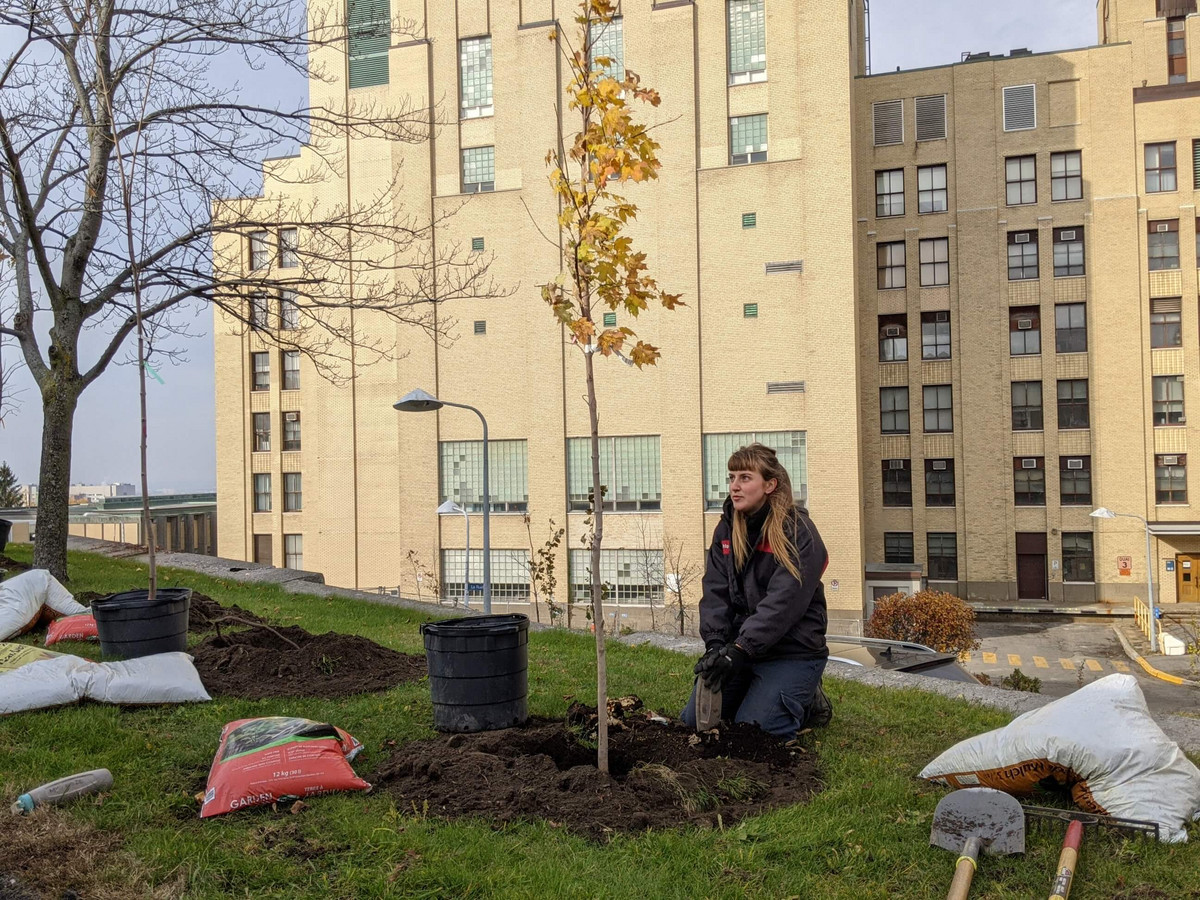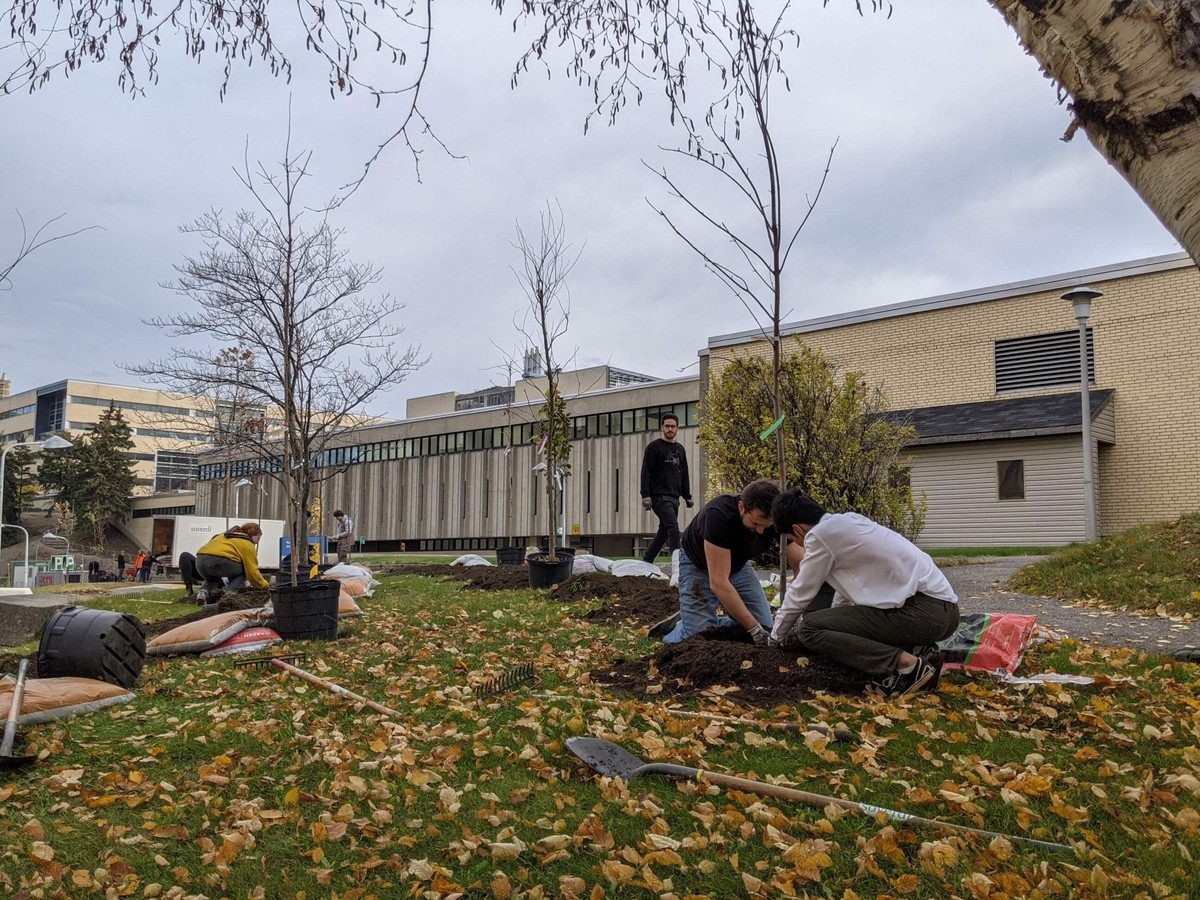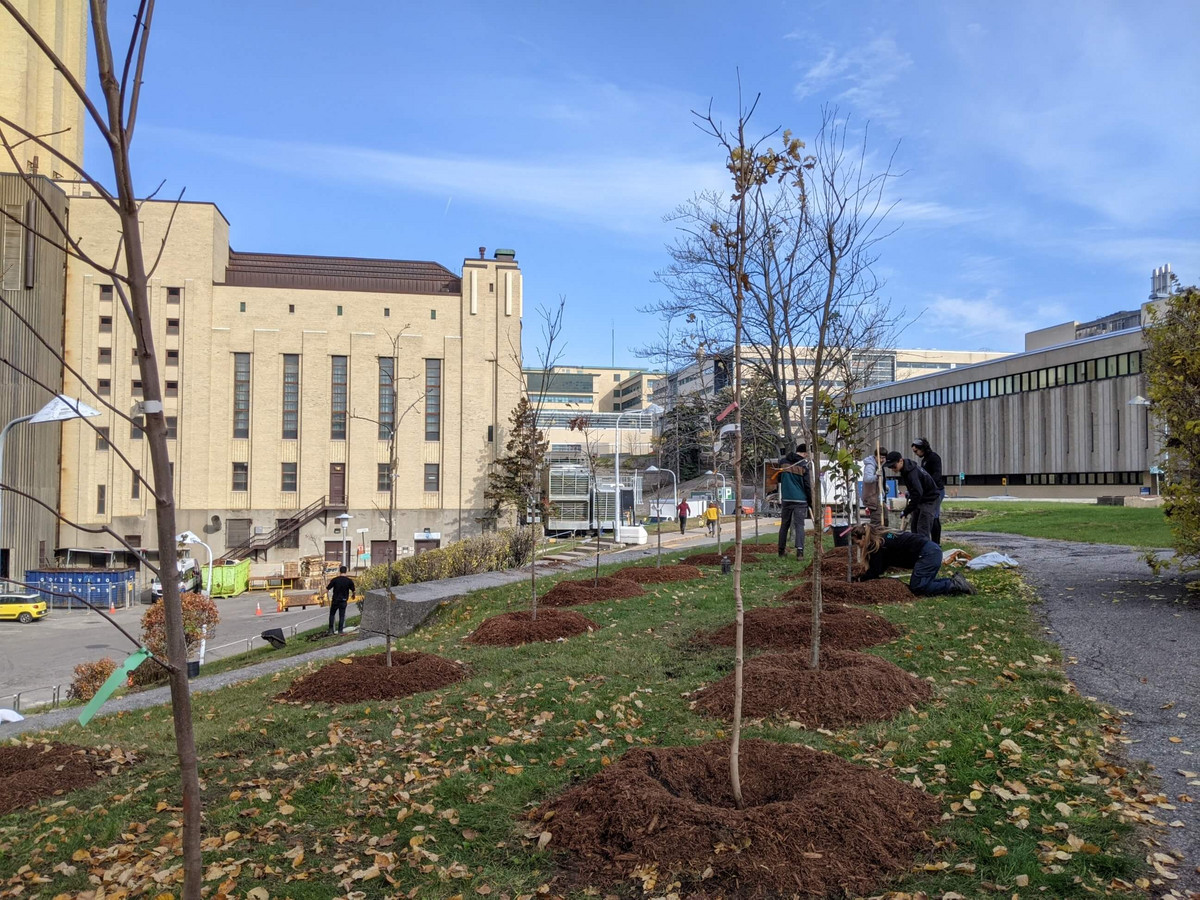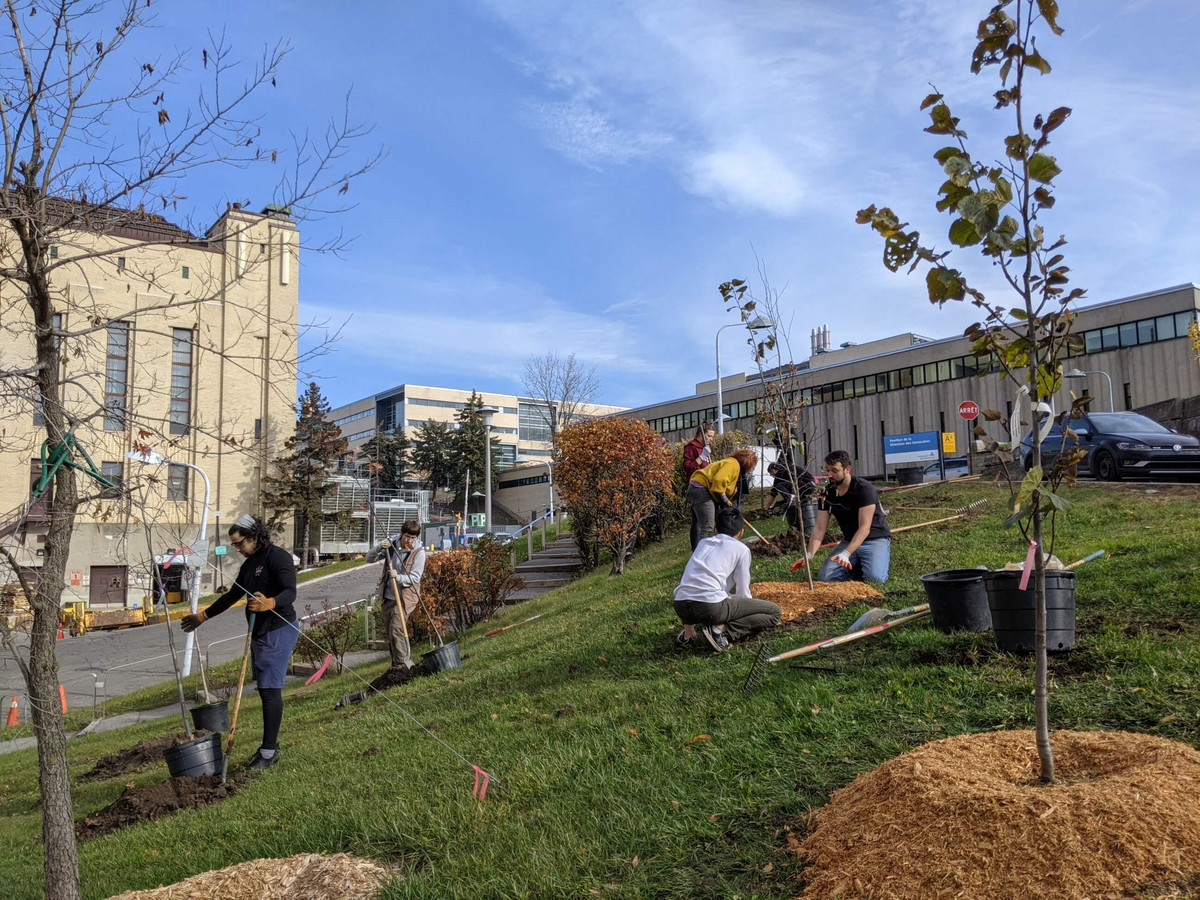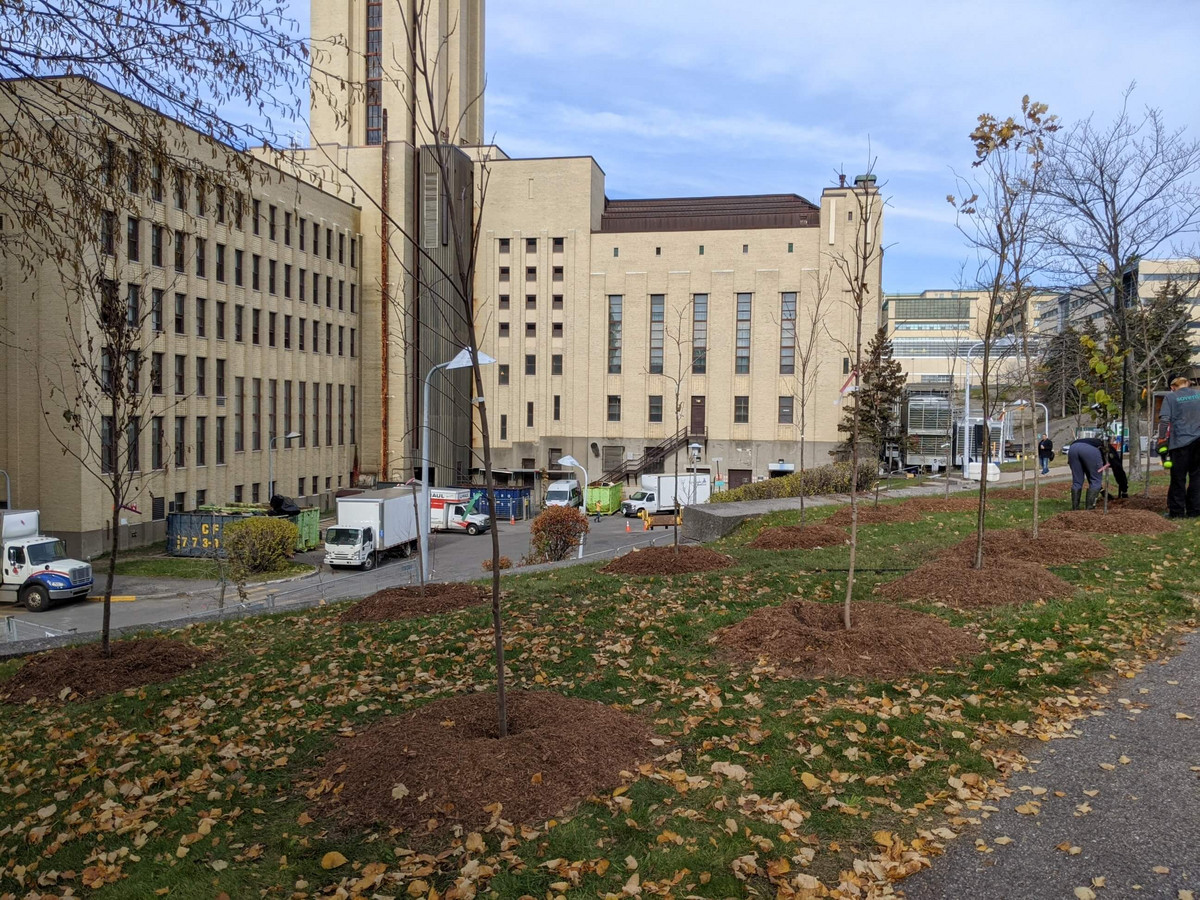Biodiversity (English)
Education and Outreach
OUR ENGAGEMENT
Why a biodiversity plan?
An alarming observation According to the Millennium Ecosystem Analysis (MEA, 2005), 60% of the free services provided by nature, such as water filtration, are being degraded or used in unsustainable ways. In addition, the number of species on Earth is declining. Indeed, in recent years humans have increased the rate of extinction of species by 1,000 compared to the rate observed over the history of the planet. In addition or in combination with this, there is intense pressure from humans. For example, between 1960 and 2000, food production has increased by a factor of 2.5 and water consumption by a factor of 2. The Convention on Biological Diversity (CBD) reminds us of the interconnectedness of these many environmental problems. Indeed, the CBD announces that "the Earth's agriculture is disappearing at an alarming rate, jeopardizing the sustainability of the services provided by ecosystems and agriculture, and their capacity to adapt to changing conditions". At present, the state of biodiversity worldwide is under threat, and the IPCC's proposed Vth Report on Climate Change (IPCC, 2014) reminds us of the importance of acting now, presenting us with the extent to which current technology allows us to be increasingly accurate in our climate models. The alarm has long been sounded and the message is clear: it is at the municipal level that action must be taken. It is the transmission of this message that ICLEI (the International Association of Local and Metropolitan Governments dedicated to SD) has made it its mission to encourage each participating city to implement a local biodiversity strategy and action plan. This goal was also reiterated in the Aichi targets (Goal 14): "By 2020 at the latest, governments, businesses and stakeholders at all levels have taken action or implemented plans to ensure sustainable production and consumption and have kept the impacts of natural resource use within safe ecological limits". As the host city of the Secretariat of the Convention on Biological Diversity, Montreal joined ICLEI's Biodiversity LAB Project in 2010, and hosted the International Symposium on Urban Biodiversity in 2013, it is clear that when they submit their Biodiversity Report (2013), our metropolis has a real desire to do its part. As a city of knowledge, a part of its actions will fall to its institutions, particularly those located on one of the city's most beautiful sources of biodiversity
Actions from our Biodiversity Engagement aiming at Education and Outreach
2-1 Participation in forums, working committees and other events in partnership with various stakeholders (City of Montreal, government departments and agencies, Les amis de la montagne, Société environnementale de Côte-des-Neiges, other stakeholders)
8-2 Realization of educational workshops for the general public, elementary school and day
8-4 Installation of information panels
8-5 Development of nature interpretation tools (kits)
8-6 Creation of a walking trail identifying remarkable plant species
8-7 Easy access to information on our biodiversity through a website and various reports
WHAT WE DO
Annual Biodiversity Summer School
https://praxis.umontreal.ca/catalogue-de-formations/sciences-et-technologies/
Arboretum
PDF Document (French)
Bioblitz - What’s a bioblitz ? A bioblitz consists in carrying out numerous biological inventories in a short period of time in partnership with scientific experts, naturalists and the community
Bioblitz report (PDF)
Leave No Trace Program
https://www.devilleenforet.com/projets-regions-municipalites/
Kids Summer camp
https://www.cepsum.umontreal.ca/eco-camp-11-12
Seeds of the future for Mount Royal (elementary schools education program)
http://www.biodiville.org/arkotheque/client/gdie/fiches_experiences/detail_fiche_experience.php?ref=46&titre
TO GO FURTHER
A surprising diversity
The complexity of Mount Royal's socio-ecological system was not built in a day. In fact, in order to fully grasp the modifications that this landscape has undergone over time, a brief history of the site was created.
The forest on the campus of the Université de Montréal covers an area of 15, 15.6 or 16 hectares depending on the study (Thiffault, 2003; Boivin et al., 2005; Pinna, 2005). Of this area, 13.44 hectares have been placed under the city's supervision by an emphyteutic lease signed in 2011, with the objective of improving access and enhancing biodiversity. This emphyteutic lease will be valid for 50 years. In spite of this transfer, the campus forest remains a mosaic of century-old forests, young successional forests colonizing disturbed sites and semi-natural spaces, also known as "trees on grass" (Boivin et al., 2005). More information on these natural and semi-natural areas of the campus can be found in the study of the same name by Boivin et al. (July 2003). This natural environment holds many surprises, much of which is made accessible by the 5,358 m of pathways that cross it (Boivin et al., 2003).
At the time, the UdeM woodlands constituted a continuous and homogeneous zone between the Outremont summit and Édouard-Montpetit Boulevard (Thiffault, 2003). As a result of numerous disturbances, the landscape has been greatly modified. From now on, this continuity has given way to a series of different settlements. The study by Boivin et al. (2005) identified these main stands making up the campus and developed an evaluation tool to visually display their respective ecological value. This division will serve as a basis and benchmark for future inventories. Pinna et al (2008) verified the relevance of this tool for assessing the ecological value of the sites during its inventory of beetles, lepidoptera (butterflies) and other insects and invertebrates.
Prior to the urbanization of the site and the destruction of the landscape, it would seem that, according to Bruce Trigger, a renowned ethnohistorian, the campus woodlands, which were very rich, served as refuges and habitats for many animals. Beavers, deer and even bears were found here before the development of the city north of Mount Royal. In his writings, he even goes so far as to denounce the development of the ski jump as the reason for the loss of the pheasant on Mount Royal. Although the size of the University's woodlands no longer covers the same area as they did a century ago, their quality and diversity still provide a home for many animal, plant and fungal species.
As Thiffaut points out in 2003 in his report produced for Quebec’s Environment ministry : "Forest stands classified as being of "ecological interest" correspond to mature stands and stands considered rare on the territory of Montreal". This is the case for oak stands, because we only find them on Mount Royal. These stands are characteristic of the extreme conditions found in the Montérégiennes, i.e. well-drained environments, more exposed to the wind and with an average annual temperature slightly lower than the level of the plain. Red oak stands are largely dominant and occupy almost all of the wooded areas on the northwestern flank, which are mature and centenarian (Boivin et al., 2005)".
History
Founded in 1878, UdeM, with its two affiliated schools, is today the largest university in Quebec and the second largest in Canada. Since the inauguration of Pavillon Roger-Gaudry in 1943, thirty-seven buildings, research and teaching pavilions, administrative buildings and student residences have been acquired or built.
In 1921, the City of Montreal modified its charter to authorize it to donate to the Université de Montréal a piece of land not exceeding 60 arpents on the periphery. In 1922, the city ceded two lots on the north side of Mount Royal to the Université de Montréal to establish its campus. One of these lots was an enclave in Jeanne-Mance Park and the other was a disused quarry on the edge of Côte-des-Neiges Parish. The university campus developed gradually, following the plan designed by architect Ernest Cormier. The Roger-Gaudry Pavilion was inaugurated in 1943.
To the east of the campus, behind the CEPSUM building, the steep slope of the site made it possible to operate an alpine ski trail from 1944 to 1981. The posts of the ski lift are still there. Part of the land transferred to the City for the creation of a park was used as a snow depot, then as a technical site, where the rock excavated during the construction of the most recent pavilions in the early 2000s was backfilled.
On March 9, 2005, under the terms of the Cultural Property Act and through the decree of the Historic and Natural District of Mount Royal, the Government of Quebec granted Mount Royal a dual protection status by declaring it the first Historic and Natural District of Quebec. This dual designation allows for the protection and promotes the harmonious development of this unique ensemble. The protected territory covers four boroughs of Montreal- Ville-Marie, Le-Plateau-Mont-Royal, Côte-des-Neiges-Notre-Dame-de-Grâce, Outremont and the City of Westmount, and includes the three peaks of Mount Royal and the major religious and educational institutions, cemeteries and several monuments and historic sites that have marked the mountain's development.
In 2008, UdeM signed the Mount Royal Heritage Pact in which the partners commit to preserving Mount Royal for present and future generations.
In 2009, the Université de Montréal, the City of Montreal and Notre-Dame-des-Neiges Cemetery joined forces to create a brand new park that will protect and make accessible Mount Royal's Outremont summit. This project was made possible by pooling 23 hectares of land owned by the University and the Cemetery on the north flank of Mount Royal.
For its part, the University is transferring to the City of Montreal a piece of land of close to 13.5 hectares to allow for the development of a new park on Mount Royal. The space transferred for a period of 50 years by emphyteutic lease is located between the École polytechnique, the Faculty of Music and the Notre-Dame-des-Neiges Cemetery. It therefore includes the former ski trail and the former UdeM snow depot. UdeM's legacy is logical, since the University agreed to stop expanding on the mountain, hence the creation of the Outremont campus to meet its need for space.
2010 creation of the Vice-Rector's Office for Student Affairs and Sustainable Development and adherence to the Montreal community's sustainable development action plan
2011 Inauguration of the biodiversity center First urban agriculture projects and installation of five hives
2013 Consolidation of the primary core of the Édouard-Montpetit woodland and installation of bluebird nesting boxes, a bat shelter and several oases with native pollinators are created as well as nesting boxes to shelter them.
Greenhouse
The greenhouse of the sustainable development unit is a project that has been implemented in the heart of the Ephemeral Projects. This 3-season greenhouse was set up to increase the production period on the site in addition to offering the opportunity to the various users to diversify their productions.
Set up in spring 2021, the greenhouse was offered to three (3) categories of actors. First, we took into consideration the needs of local partners (ephemeral projects) who have been requesting it for a few years (2016). Then, in order to bring science to life on the site, a section is reserved for research in connection with the departments present at the MIL Campus (Geography, biology, chemistry, physics). Finally, a last section is offered to the local food services of the University of Montreal. Each group of actors is therefore offered a third of the surface (1050 sq. ft.).
Following this first season, everyone was able to appropriate this new infrastructure in the heart of Montreal. However, some issues have emerged, for example, the lack of a tool to monitor the uses and users (inputs, outputs) and of a set of specifications in addition to losses due to the presence of pests.
In 2022, as we entered the second season, we were able to make some corrections thanks to the hiring of a greenhouse technical assistant. In addition to providing an excellent support service to users, we were able to introduce ladybugs in order to integrate an integrated management component (biological control of aphids), an intervention that has been very successful. Also, we now have intervention sheets according to the various pests that have been encountered so far in order to empower users in the long term.
The greenhouse now provides many resources. You may have tasted a ginger or hibiscus Kombucha, two exotic plants now in local production.
Invasive Alien Species
OUR ENGAGEMENT
Actions from our Biodiversity Engagement aiming at Invasive Alien Species
1-3 Redevelopment of habitat for native species, whether by maintaining natural habitats or by developing shelters, nesting boxes and tree plantings
1-5 Control of invasive species
3-1 Updating existing inventories
3-2 Realization of new inventories
6-1 Development of a green space management plan for the Mountain and St-Hyacinthe
ACTIONS
1. Recognize that invasive species are a major threat and that they must become a priority issue in safeguarding the ecological integrity of Mount Royal.
2. Create a management plan including an intervention and monitoring program. The main objectives of this program are the eradication of invasive species already established on Mount Royal and the restoration of its ecological integrity. It is imperative that sufficient resources be allocated to ensure its success.
3. Continue measures to prevent new introductions of exotic plants through regulation and awareness raising for institutions and residents near the mountain.
4. To develop a monitoring system that will allow us to act as quickly as possible to counter new introductions of invasive plants.
5. Restore the environment following control activities, including the planting of native species, in order to encourage the return of natural communities and prevent recolonization by invasive species.
6. Prioritize research on the scope of the problem, the effectiveness of interventions and the actions to be taken (investigate control methods).
7. Raise awareness of invasive plant issues among park users, particularly to prevent environmental disturbances (off-trail walking and cycling) that contribute to the establishment of invasive species.
8. Promote an action partnership with residents, institutions and organizations (e.g., create volunteer control or eradication days).
9. Disclose the results of the actions carried out and the research undertaken to promote the exchange of knowledge with the scientific community and other associations protecting woodlands invaded by the same species, notably the Parcs-Nature de Montréal and other protected woodlands in the greater metropolitan area
Management of Invasive Alien Plants on Montreal’s Royal Mount
Threatened Species
OUR ENGAGEMENT
Natural space and conservation
A university approach
UdeM has always been a source of progress and contributes to the resolution of the various challenges facing society, and biodiversity is one of them.
Mount Royal is inseparable from the history of Montreal and the Université de Montréal, which proudly bears its name beyond its borders. Our campus is 60% green space and is home to an entire ecosystem that the University is committed to protecting. This is why we plan our development in harmony with the geophysical conditions of the city. And we make our own the principles of sustainable development that guide the management of major projects in our society.
The University works not only to preserve Mount Royal, but also to enhance it. In 2009, we transferred a 13.5-hectare site to the City of Montreal to create a new public park on the north side of the mountain. Third Summit Park will offer Montrealers a breathtaking view of the Laurentian foothills. By participating in the creation of this park, the University is strongly demonstrating its attachment to Mount Royal, its home for nearly seven decades. [1]
In 2011 we inaugurated the Biodiversity Centre in partnership with the City of Montreal. Biodiversity is more than ever at the heart of our concerns. We want to go even further by presenting the UdeM Biodiversity Plan, a document that constitutes a first university approach in the Quebec metropolis that promotes both the maintenance of biodiversity and public awareness of its issues.
It is our duty to protect our common good in order not to leave a heavy and sad legacy to the generations that will succeed us. How will we justify to our children the disappearance of bats, the silence of amphibians in our ponds or the absence of pollinators in our forests?
The Université de Montréal wishes to enhance and maintain the biodiversity of the northern flank of Mount Royal To carry out such an undertaking, the Université de Montréal is adopting a nine-point 2012-2020 Biodiversity Engagement.
Actions from our Biodiversity Engagement aiming at Threatened Species
1-3 Redevelopment of habitat for native species, whether by maintaining natural habitats or by developing shelters, nesting boxes and tree plantings
1-4 Helps to maintain the local flora by closing illegal trails : Trails through campus woodland stands are the result of random and uncontrolled development, which ultimately causes extensive damage to the soil.
3- Ensure the realization of inventories and monitoring of the species present
3-1 Updating existing inventories
3-2 Realization of new inventories
6- Establish a green space management plan for the different campuses
6-1 Development of a green space management plan for the Mountain and St-Hyacinthe
7-1 Installation of nesting boxes and shelters
WHAT WE DO
Inventories
- Oval-leaf Sedge (Carex cephalophora)
- Mayapple (Podophyllum peltatum)
- Barn Swallow (Hirundo rustica)
- Peregrine falcon (Falco peregrinus anatum)
- Stick insect or phasmid (Diapheromera femorata)
- Question Mark butterfly (Polygonia interrogationis)
- Little brown bat or Vespertilion of Yuma (Myotis lucifugus)
- Silver haired bat (Lasionycteris noctivagens)
- Eastern pipistrelle (Perimyotis subflavus)
- Ringneck Snake (Diadophis punctatus edwardsii)
These are species with various statuses: "endangered", "threatened", "vulnerable", "Likely to be designated threatened or vulnerable (provincial status)", "concerning" according to COSEPAC or Ministère de la Faune Forêt Parc : https://cosewic.ca/index.php/fr/
Reduce cutting of grass near sensitive environments
Upcoming information
Addition of American Bluebird Shelters
Upcoming information
Construction of bat shelters
Upcoming information
Biodiversity Engagement
Biodiversity Report 2018 (PDF)
Biodiversity Report 2016 (PDF)
The Montreal Climate Partnership
A dynamic initiative built on the expertise of existing organisations
The Partnership is an independent initiative, which brings together economic, community, philanthropic and institutional organizations recognized for their level of commitment to the climate issue and their capacity to influence. The project is ambitious: to mobilize the key players in the Montréal community to help reduce GHG emissions by 55% by 2030 and put the city on the path to carbon neutrality by 2050.
As a member, Université de Montréal participates as a consulting partner on climate change adaptation.
Planting with SOVERDI and Alliance forêt urbaine
In October 2021, we planted 51 trees in partnership with SOVERDI as part of our engagement with Alliance forêt urbaine (Urban Forest Alliance). This activity was made possible thanks to the participation of a dozen volunteers.
| Species | Qty |
|---|---|
| Acer rubrum | 5 |
| Acer saccharum | 3 |
| Amelanchier 'Laevis Snowflakes' | 1 |
| Amelanchier Laevis | 1 |
| Betula alleghaniensis | 5 |
| Carpinus caroliniana | 5 |
| Celtis occidentalis | 2 |
| Larix laricina | 3 |
| Ostrya virginiana (PAC) | 4 |
| Ostrya virginiana (MOY) | 1 |
| Quercus alba | 3 |
| Quercus bicolor | 3 |
| Quercus macricaroa | 4 |
| Quercus rubra | 5 |
| Tilia americana 'Redmond' | 5 |
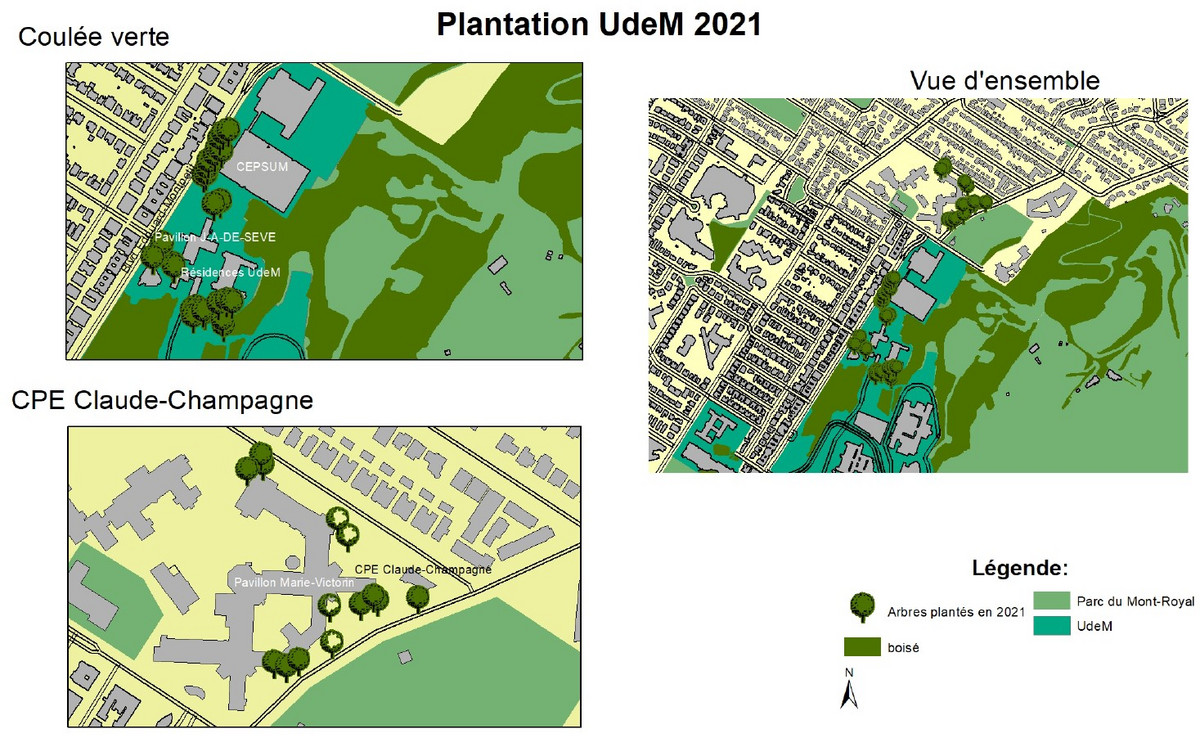
Pictures of the plantations


